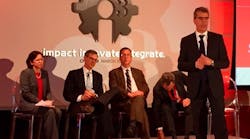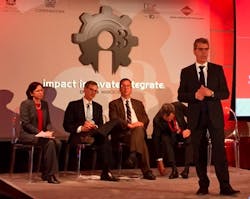Democratization and glorious data: The future of American manufacturing
What will define the future for American (and global) manufacturing? To start, more-flexible production lines, a more-democratized environment for product development, and a rethinking of workforce roles as automation advances, according to several U.S. and Italian leaders of industry and academia speaking in Chicago this week.
Chicago Mayor Rahm Emanuel, Italian Prime Minister Matteo Renzi and top players from businesses and institutions such as Italian machine tooler Galdabini, TeleRobotLabs, and Chicago's DMDII advanced manufacturing institute talked trade and manufacturing trends on Wednesday at Impact. Innovate. Integrate, an event sponsored by the Italian Trade Agency.
[javascriptSnippet ]
Manufacturers "need to be provocative" to make a more-nimble and more highly connected future a reality, said Eugenio Bassan, CEO of Salvagnini America, which provides automation tools and industrial machinery for sheet metal processing.
"In North America, one of the biggest challenges is velocity," Bassan said. "Lot sizes are getting smaller and time to market is shorter." The ability to transform the idea of an object into the object itself quickly is key for manufacturers looking to gain market share and increase revenue, he said.
Mario Taisch of Politecnico di Milano speaks at the Impact. Innovate. Integrate forum in Chicago
The concept of "batch 1" – producing a single, customized batch of a particular product for a customer – came up repeatedly during panel discussions. In the automotive space, noted Edward Vella, president of electronic metrology systems specialist Marposs Corp., today's consumers are looking for cars built to their tastes without a major upcharge attached to that customization. It's a trend that consumers have grown accustomed to in fast food, he said – why can't or shouldn't that flexibility be available for other products? "Carmakers that are able to implement flexibility … on a global scale will be the most successful," Vella said.
Luigi Galdabini, CEO of Galdabini, shared the sentiment. "There is, I would say, a desperate demand for flexibility," especially in the automotive industry, he said. OEMs, too, are feeling the pressure to deliver customized equipment that offers unprecedented accuracy, he said.
What's going to enable companies to reach these new heights of flexibility and accuracy? Advanced robotics, 3D printing and carving tools, and smart wireless sensors will be vital, panelists said.
"All machines have to talk to each other within a plant, and they have also to talk with the producer," said Matteo Benedetto, vice president of marketing for Prima Industrie, a manufacturer of 2D and 3D laser cutting machines.
>>>"That's the key to the future, the intelligent use of data in all of its forms." – Jacob Goodwin, chair, DMDII
"If we can extract data at every stage of the production process and send it up to the cloud … that's the key to the future, the intelligent use of data in all of its forms," said Jacob Goodwin, chair of DMDII, one of seven institutes in the federal National Network for Manufacturing Innovation.
Of course, making data more accessible (literally and figuratively) for everyone from engineers to executives to technicians also will be essential. The full realization of Industry 4.0 – "the next big thing in manufacturing," said Vella – will require being able to measure and control processes in real time, making sure data is available to anyone who needs it, and making operator interfaces easier to use and customizable so that workers of varying backgrounds, skill levels, and physical abilities are able to do their work more easily.
>>>"The value of the human is to use his brain." – Eugenio Bassan, CEO, Salvagnini America
The workforce implications for more-connected, more-flexible, and more-automated production facilities are significant, panelists agreed. But the story isn't a doom-and-gloom one of robots putting everyone out of work, they said.
"Humans are underrated," said David Corsini, a mechanical engineer and the founder of Italy's TeleRobotLabs. But their greatest asset, said Corsini and Bassan, is in the creativity and imagination that they bring to the table. "The value of the human is to use his brain," opined Bassan. He posed a question: How can technology, taking over tasks that require strength, speed, or accuracy that humans can't achieve on their own, free up workers to engage their minds and develop or fine-tune products and devise new solutions to problems?
If it sounds like some kind of sci-fi utopian future, consider how much things already have changed in just the past 5–10 years, speakers said. "Single engineers or people with an idea can download free software (and) carry it to somebody who will 3D print it – they can do that very quickly," noted Hugh Sullivan, chair of Manufacturing Hub (mHub) Chicago and a vice chairman in investment banking at Morgan Stanley. "That is bringing a new level of democratization, if you will, to the product development process."
This democratization goes beyond engineers and other industry professionals, too, according to Marco Taisch, a professor in the economics, management, and industrial engineering department at Milan's Politecnico di Milano. "I think we will go from Internet of Things to Internet of People, Internet of Services," he said. "Customers will help to design new products."
DMDII's Goodwin observed that the new generation entering the industrial workforce already is comfortable with technology-enabled collaboration. "They're familiar with collaborative enterprises (such as Wikipedia) that didn't exist for previous generations," he said.
Making better use of what new technologies are enabling will require significant shifts in processes, approaches, and workforce development, panelists suggested. Still, they offered, the future for manufacturing – in the U.S. and abroad – is promising. "In Europe, a lot of times, we feel a climate of fear of the future," said Prime Minister Renzi. "We consider the future as a great threat, not a great opportunity." He continued: "My message is only one … the future is better than the past."

